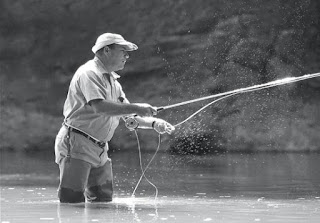Two years later (it took longer than I imagined), was on the plane, on my way to Oslo where I was going to meet the rest of the group. The next day, we took the plane to Kirkenes, then headed a minibus to Murmansk. The road to the biggest northernmost European harbor city was long and tedious. The check-in was followed by a hot shower and a copious meal, after which I retired to save my forces for the next day.
Around midday, we boarded again in minibusses and headed for the helicopter, an old IM-8. We arrived late at the point of departure. While waiting for the chopper, we met some fishermen from Argentina who fished the Belousiha and Voronia river for salmon and had a chit-chat. They complained about the very high water level.
Altogether we were four groups. The helicopter made its appearance with deafening noise. After boarding, a short flight followed to the famous base camp on the Rynda River. The disinfection of the equipment began while a cold breeze from the Barents Sea was blowing. A fisherman tried his luck in the Rynda home pool from a boat. As long as we stayed there, his attempts to catch a salmon were futile.
After the first two groups departed, it was our turn to get the stuff into the chopper. We made the boarding with running engines to save time. As we got up from the ground, the chalets on Rynda became smaller and then fade into the vast field of the tundra. For a while we flew East, alongside the coast, passing the mouth of Eastern Litza River, which was extremely swollen, then took the curse to Kharlovka Dreampool. There were large stretches of land covered by snow. As a Kola novice, it was hard to make an appreciation from the air, but when I spotted the majestic Kharlovka with its immense luster of water and the shores partly covered with ice and snow, I looked at Lars face, who knew the area as well as his own pockets and realized it was not good. I was excited and somewhat disappointed about what we found. It wasn't exactly what I imagined.
Gathered over the luggage, we stared at the helicopter that was getting smaller and rotor noise became a barely perceptible sound, then disappeared completely. For a short time, we were surrounded by an abyssal silence.
We watched for a while the water surface without to see any rising fish, then started our casts into the unknown. After a few hours of futile fishing, the sensation of angling in a bathtub was getting stronger and stronger. The walk along the swampy banks was a tough job. Tired, we decided to end our fishing day. It was past three o'clock in the morning when we arrived the tents. Next morning, while taking breakfast, we saw pictures of the first landed trout, a beautiful specimen over 4 lb caught by Javier.
With fresh forces, we began fishing the upstream places, meter by meter. Suddenly Andre gave me a sign. His rod was bent and he needed help. Unfortunately, it was not the expected fish. A 5,5lb pike felt attracted by his zonker. Another day passed without trout activity. High water and low temperature, delayed the hatching of insects.
Next day, we crossed the river with a pneumatic boat and went looking for the fish in one of the lakes in the area. Andre showed me a hot spot that I fished with a small caddis nymph and brought me the first fish, a 1lb trout, a small specimen for these waters. Meanwhile, Mike and Erik managed to catch some nice fish from the boat using big furry streamer and sinking lines. It was time to change strategy.
(to be continued)
We managed within an hour to raise the entire camp. The third day since I left home, was coming to an end. Adrenaline and the desire to fish the water we dreamed for so long, have made us move more easily over the fatigue accumulated during the last days. Together with Andre went fishing the area downstream the camp, while the rest of the team remained to fish the home pool.
We watched for a while the water surface without to see any rising fish, then started our casts into the unknown. After a few hours of futile fishing, the sensation of angling in a bathtub was getting stronger and stronger. The walk along the swampy banks was a tough job. Tired, we decided to end our fishing day. It was past three o'clock in the morning when we arrived the tents. Next morning, while taking breakfast, we saw pictures of the first landed trout, a beautiful specimen over 4 lb caught by Javier.
With fresh forces, we began fishing the upstream places, meter by meter. Suddenly Andre gave me a sign. His rod was bent and he needed help. Unfortunately, it was not the expected fish. A 5,5lb pike felt attracted by his zonker. Another day passed without trout activity. High water and low temperature, delayed the hatching of insects.
Next day, we crossed the river with a pneumatic boat and went looking for the fish in one of the lakes in the area. Andre showed me a hot spot that I fished with a small caddis nymph and brought me the first fish, a 1lb trout, a small specimen for these waters. Meanwhile, Mike and Erik managed to catch some nice fish from the boat using big furry streamer and sinking lines. It was time to change strategy.
(to be continued)






























